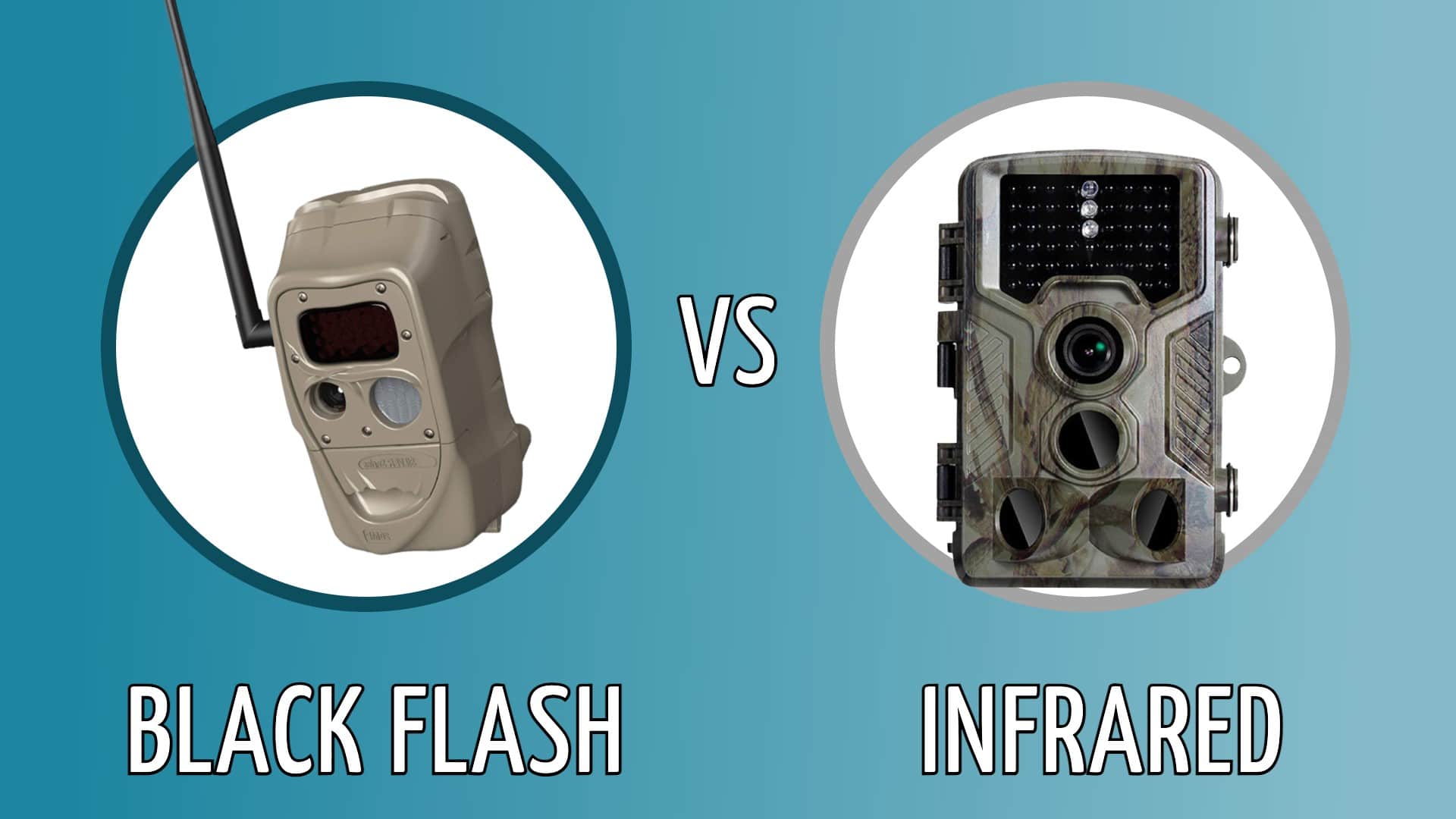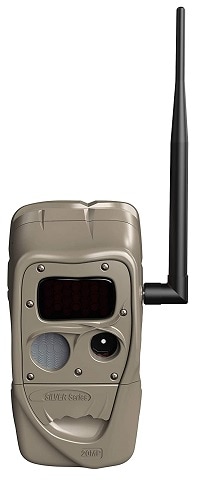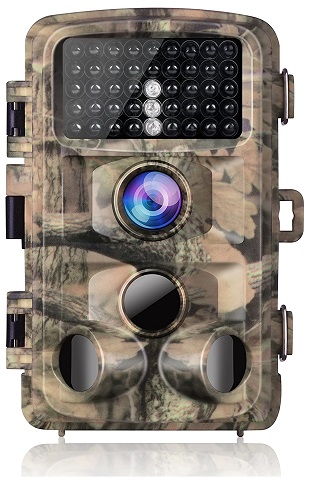Black Flash vs Infrared Trail Cameras: Which Is Best for Your Needs?
Last Updated on

To start with, the first thing the reader should know is that as with anything else, you get what you pay for. Although many trail camera users prefer the black flash camera due to its stealthier operation, there are disparities in quality within this line of products as well. In this article, a breakdown of each type of trail cam will be examined as well as their respective advantages and disadvantages.
Infrared (IR) trail cams are an improvement upon the white flash and other types of older trail cams. IR technology is also a step above traditional night vision as doesn’t require ambient light to operate. Additionally, many IR cameras have a reputation for taking relatively clear pictures of moving objects.
Black flash, or no-glow, is a variant of the standard IR cameras, essentially have a system of black-filtered LED lights that provide illumination on a part of the spectrum invisible to humans and game animals. Considered an improvement on traditional IR by most for various applications, further information will be presented to show why.

Black Flash Trail Camera Overview
The “black flash” IR camera is an adaptation of the standard IR camera where black LEDs, emitting light on a different part of the spectrum that is invisible to humans and animals, enable image capture at night without alerting animals to their presence. The big advantage is that these cameras are ideally suited for placement in very close proximity to animals for undetected observation.

Like the standard IR options, there is a place for these cameras in security use where discretion is necessary. In these applications, a more suitable use might be alleyways, gated entryways, or small yards. However, the clarity is not what it could be with standard IR so its effectiveness for identifying an intruder may not always be as good, especially at distance.
If one is contemplating which option is best for spotting less commonly glimpsed animals like, bobcats, wolves, or coyotes, then “black flash” is the way to go. These animals are very perceptive and defensive and it’ll be hard enough to catch them on camera without lights further undercutting the effort.
- Undetectable to humans and animals
- Blurriness in nighttime shooting, sometimes severely so
Related Read: How to Hide Your Trail Camera From Humans & Deer

Traditional IR Trail Camera Overview
A standard IR trail cam uses a faint light source that usually appears red to the naked eyes and takes a picture or video of what shows up in its field of view. Infrared imaging is the preferred method of nighttime imaging. It has a black and white display for night-time shoots with color available in daylight. Low glow technology enables you to take pictures at night without disorienting animals or people the way an older white flash camera might.
Generally, low glow IR cams take pictures in the 10-30 MP range but it’s important to note that the megapixel count is not the stand-alone measure of image clarity. Other factors to consider are lens quality (where you really, really get what you pay for), shutter speed, flash range, LED count, and field of view in degrees, known as the PIR angle, or “passive infrared”.
So, why do some companies go with slower trigger speeds, fewer LEDs, and lower quality lenses? Cost savings. There is a market for low-end products and honestly, every application doesn’t necessarily need a high-end trail cam which is a decision for the user to make.

Inexpensive options are still suitable if the intended purpose is to locate game and get a better idea of where to go and spend less time in the woods.
But there are ways to determine whether or not a camera is a high-quality one or not without paying attention to the marketing. These factors include the ones listed above plus a few more.
The range of a trail camera is helpful if your placement is ideally situated and game doesn’t necessarily walk within the shorter range of a “black flash” camera for instance. Low glow IR trail cams are generally the leaders in range of view. The amount of light they emit does enable some of them to have a range several times further than other trail cam options. In terms of clarity, IR cams also do generally outperform black flash options. But the red glow will attract the attention of deer and other big-game animals and may cause them to move to another area if they’re in a heavily hunted area.
In security applications, the lighting and range can be helpful as both a means to identify an intruder, as well as provide a slight deterrent. Burglars, if they’re paying attention, will see the glow from the camera. Many criminals disregard cameras and proceed anyway but if nothing else, these cameras are a good resource for identifying them later.
IR Low Glow Considerations
These cameras are a fair option in wildlife observation for non-hunting purposes, vary widely in quality, and are readily adaptable for security purposes. Looking for a camera angle of 45-48 degrees ensures that the camera is most likely to catch everything in its field of view in general circumstances. Narrower angles can be useful if you have one set to look straight down a trail with thick vegetation on either side. You won’t need a wide angle here as the camera likely won’t capture anything clearly. Finally, keep in mind the sensitivity rating. Low sensitivity cameras will disregard the small stuff like rodents and small snakes while high sensitivity cams could almost pick up a leaf falling. Higher end cams will have an adjustable setting and is a good option to have if versatility is desired.
All things considered, IR is a great option and one commonly used when clarity and large fields of view are desired. Pay attention especially to the particulars of sensitivity, detection zone, field of view or “PIR angle” and don’t put too much stock into megapixels and battery life as these terms can mislead you.
- Better clarity
- Range
- Adaptability
- Light emitted will attract the attention of big game.
- Can have a lower battery life

Other Factors to Consider
As has been previously touched on, watch out for marketing gimmicks. Camera makers know that the field is a highly specialized one and that the layman may have trouble discerning how their terminology will actually translate. Here are some things to look out for.
Megapixel counts are usually interpolated through digital means. Without getting too technical the quality you get is a digital add-on when a computer essentially guesses what details would be at resolutions higher than what is actually depicted by the camera itself. Most cameras have 4 or 5 pixels at best.
Battery life ratings by the trail cam companies are misleading. As the company selling their product can’t accurately guess how much an individual cam will be used, they rate their battery life based on the life of a set of batteries used to power a trail cam that does nothing but sit on the shelf, unused.
You might also be interested in: 10 Best No-Glow Trail Cameras – Reviews & Top Picks

Final Thoughts
As prices vary so widely and there are so many manufacturers in this market, price listings or comparisons between individual brands could fill up several more articles. The best advice here is to start by shopping for need, look for a brand with good reviews, and research the company and product so that the leap of faith is more like a long step in the right direction.
You might also be interested in: 10 Best Trail Cameras – Reviews & Top Picks
About the Author Robert Sparks
Robert’s obsession with all things optical started early in life, when his optician father would bring home prototypes for Robert to play with. Nowadays, Robert is dedicated to helping others find the right optics for their needs. His hobbies include astronomy, astrophysics, and model building. Originally from Newark, NJ, he resides in Santa Fe, New Mexico, where the nighttime skies are filled with glittering stars.
Related Articles:
What Is the Best Binocular Magnification for Hunting? Optical Features Explained
How to Clean a Refractor Telescope: Step-by-Step Guide
How to Clean a Telescope Eyepiece: Step-by-Step Guide
How to Clean a Rifle Scope: 8 Expert Tips
Monocular vs Telescope: Differences Explained (With Pictures)
What Is a Monocular Used For? 8 Common Functions
How to Clean a Telescope Mirror: 8 Expert Tips
Brightfield vs Phase Contrast Microscopy: The Differences Explained
